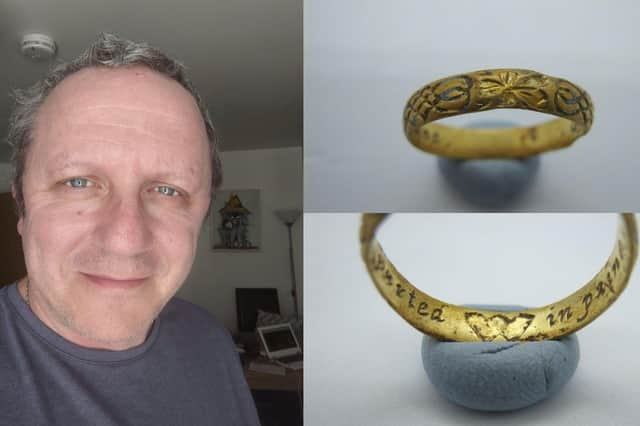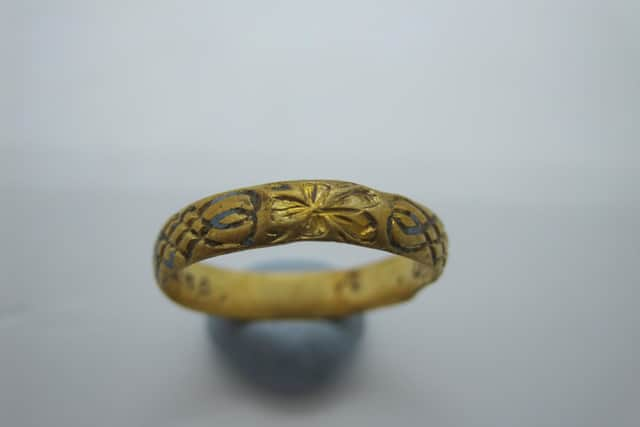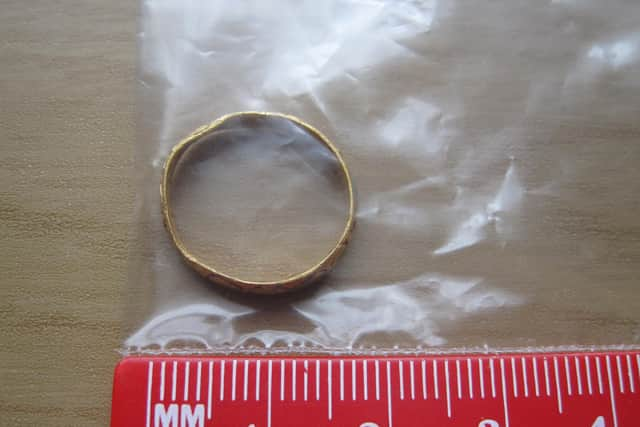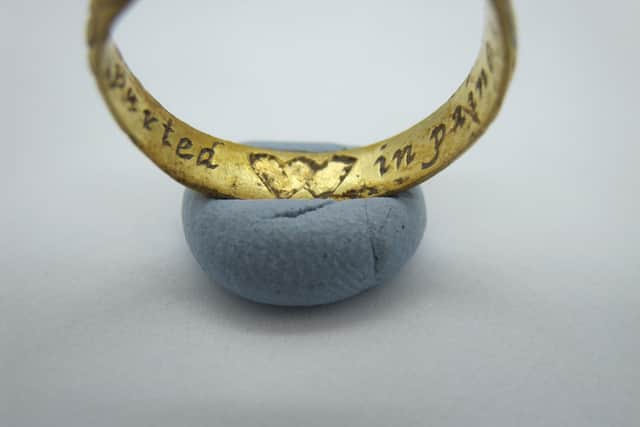Scottish metal detectorist uncovers 17th century gold 'lovers' tiff' posy ring in Helensburgh field


Robin Potter, 50, from Argyll and Bute found, the 400-year-old ring in a farmer's field in Helensburgh in June this year.
The keen metal detectorist is currently waiting to hear if the rare romantic piece of jewellery will be claimed by the National Museum of Scotland.
Advertisement
Hide AdAdvertisement
Hide AdThe ring features an engraving inside which reads: "Gife parted hearts in paine".


The word 'hearts' has been replaced with two overlapping heart symbols.
Robin, from Helensburgh, believes the tiny gold ring could have been discarded after a lovers' tiff or lost 'in the heat of passion'.
Posy rings were given as tokens of love between the 16th and 18th centuries with a short poem inside kept a secret from all but the two lovers.
The name posy is a derivative of poetry, meaning short rhyme.


Full time carer Robin said: "When I found it I was so happy I cried.
"It really is a thing of beauty, and it is the first piece of gold that I have found since I started metal detecting around four years ago.
"When you find something like this you go through a range of emotions from shock to pure joy.


Advertisement
Hide AdAdvertisement
Hide Ad"Before detecting any field I check with the owner which field I can detect so I am not disturbing the animals while they are lambing or calving.
"It just happened that that field was empty that day.
The ring has a diameter of only 15mm and is thought to be either a woman's or girl's given its petite size.
Robin added: "A lot of them (posy rings) are plain on the outside so mine being engraved on the outer with flowers and a crisscrossed pattern with entwined hearts on the ends even more special.
"There are also traces of blue enamel in the criss-cross pattern which again makes it rarer.
"Honestly, it's impossible to say how it was lost.
"It could have fallen off on a cold day, it could have been thrown after a lovers tiff or it could have been lost in the 'heat of passion', who knows.”
The ring will be returned to Robin if it is not claimed by the museum, and he plans to sell it and split any profits with the landowner of the farm in Helensburgh where he found it.
He said: "The day started off pretty normal.
"I had dug several signals which turned out to be random bits of iron and then on about the fifth signal I wasn't going to dig it as it wasn't that strong but I went ahead anyway.
"I started to pull the soil apart and there it was, I could just see the side of the ring but I knew instantly it was gold.
Advertisement
Hide AdAdvertisement
Hide Ad"I slowly pulled the remaining soil away and could see the extent of the outer engraving and then looked inside the band to see the inscription.
"I have been detecting for about four years now.
"I actually love the variety of items that can be found as well as being out in the beautiful countryside.
A message from the Editor:
Thank you for reading this article. We're more reliant on your support than ever as the shift in consumer habits brought about by Coronavirus impacts our advertisers.
If you haven't already, please consider supporting our trusted, fact-checked journalism by taking out a digital subscription.
Comments
Want to join the conversation? Please or to comment on this article.
